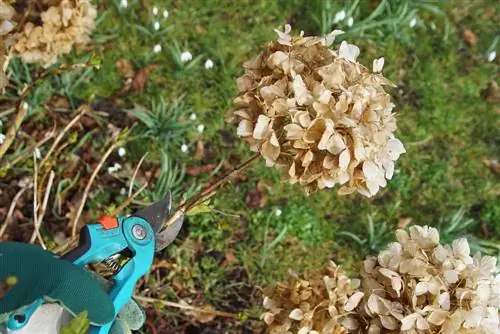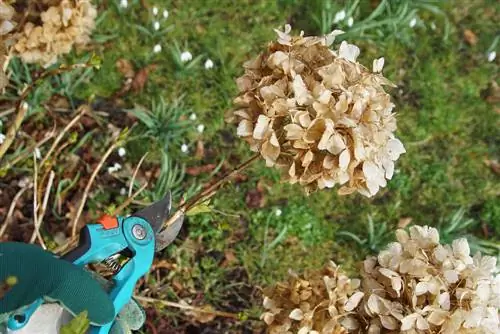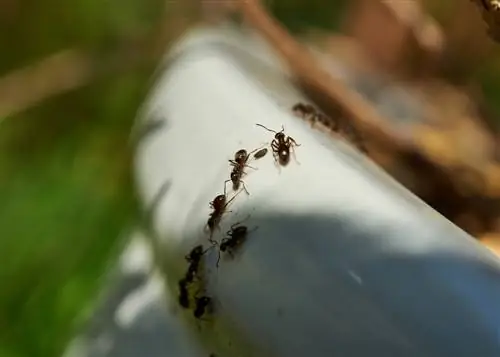- Author admin [email protected].
- Public 2023-12-16 16:46.
- Last modified 2025-01-23 11:22.
You don't necessarily have to dig up hydrangeas to reduce, propagate or remove dead ground shoots. Deadheading has proven to be an effective method so that a hydrangea mother plant can remain largely undisturbed in its familiar location. Read here how to properly deaden a hydrangea.

When and how should you deadhead hydrangeas?
Autumn is the recommended time to successfully cut hydrangeas. The root ball is exposed, runners and ground shoots are separated from the mother plant and then planted in acidic substrate at the new location. Deadheading is used to reduce, multiply or remove dead shoots.
When is the best time to deadhead hydrangeas?
Autumn is the best time to deadhead hydrangeas. Ideally, you should wait until the tree sheds itsleaves. During the dormant period of growth that then sets in, a hydrangea tolerates the procedure without causing any injuries.
A second time window opens between late winter and early spring in conjunction with the annual pruning. The disadvantage of this choice of date is that for most garden hydrangeas you have to reckon with a loss of this year's flowering period.
How do I properly deaden hydrangeas?
As utensils for deadening hydrangeas you will need a spade, a digging fork, a saw andacidic substrate, preferably rhododendron soil. The following short instructions explain step by step how to properly cut a hydrangea:
- Shovel out runners or ground shoots with roots at the edge of the root ball.
- Put the digging fork underneath and loosen the bale piece.
- Pick off the root strands with a spade and lift them out of the ground.
- Separate stubborn runners from the rootstock with the saw.
- Dig a planting hole in a partially shaded location and fill it with substrate.
- Plant the cut root piece, press down the soil and water.
- For overwintering, cover the planting site with leaves and brushwood.
Why do you want to deadhead hydrangeas?
It may make sense for you to deadhead your hydrangeas for various reasons. Hobby gardeners rate the particular advantage of this measure as the fact that the mother plant can remain in the provenlocation. These are the four most common reasons for deadheading hydrangeas:
- Shrink hydrangea
- Dividing hydrangeas without transplanting.
- Vegetative propagation by runners.
- Remove dead shoots in the outer ball area as a result of frost damage.
Can you deadhead all hydrangeas?
Basically all hydrangeas are suitable for deadheading. This applies regardless of whether you want to reduce the size of a hydrangea, clean it of frost damage or divide it.
On the other hand, only a few hydrangea species are suitable forpropagation through runners. Farm hydrangeas (Hydrangea macrophylla), panicle hydrangeas (Hydrangea paniculata), climbing hydrangeas (Hydrangea petiolaris) and most plate hydrangeas (Hydrangea serrata) thrive as bushy, compact shrubs. In contrast, snowball hydrangeas (Hydrangea arborescens) and Korean hydrangeas (Hydrangea serrata f.koreana) long runners that you can cut off and transplant.
Tip
Propagate hydrangeas gently through cuttings
Pruning off hydrangeas for the purpose of propagation means brutal intervention on the rootstock for the mother plant. It can be done more gently using head cuttings. Ideally, in early summer, cut a cutting without buds, remove the leaves except for a pair of leaves and plant it in poor sowing soil. Put a transparent hood over the growing pot and ventilate it daily. Hydrangea cuttings also root in a vase with rainwater.






